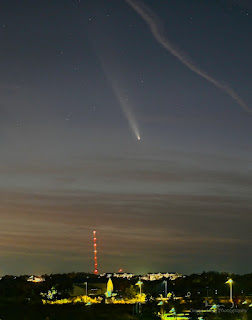
Optimists for the Comet C/2023 A3 Tsuchinshan-ATLAS were predicting brightness surpassing the planet Venus and possibly being visible during the daylight. Reality was that the comet shone at a magnitude of about 3.3 for the northern hemisphere in late September (2024), and was viewed low in the eastern sky before dawn. It shifted to the evening sky on October 10 and made its closest approach to Earth on October 12---which was to be its brightest and best viewing evening. Alas, on October 11, 12 and 14 in the Cedar Rapids, Iowa metro area skies were overcast, precluding any possibility of seeing it on those dates. October 13 offered a brief opportunity to finally see it. On October 13 the comet was beginning to dim (magnitude 3), but I was still able to locate it with the naked eye after the sky began to darken. I had seen a locational graphic on the internet, showing its position roughly between the -3.97 magnitude planet Venus and the -0.07 magnitude star Arcturus. This proved to be very helpful as I had expected it to be closer to Venus. The image above, captured at 7:13 pm CDT, looks west from Lowe Park in Marion, Iowa (42° 4'5.11"N, 91°36'17.06"W), and is a 5 second exposure at f/4, ISO 125, 37mm focal length. The identical image below contains helpful descriptions of the celestial bodies.
7:28 pm. Growing darkness reveals more of the comet and its tail. 3 second exposure at f/4, ISO 400, 59mm focal length.
7:32 pm. 4 second exposure at f/4, ISO 400, 59mm focal length. By 7:45 pm, the comet became more diffuse and dimmer as it dipped lower toward the horizon and its thicker atmosphere.
Cropped version of the image above it. I would view this comet as slightly less impressive than the Comet Neowise (2020). The best and brightest comet I have ever witnessed was Hale-Bopp in 1997, which peaked at magnitude -1.8, and coming in second was Comet Hyakutake, which peaked at magnitude 0 the year before. Major busts to the eye were the comets Kohoutek in 1973-74 and Halley in 1986. Comet Tsuchinshan-ATLAS continues to be visible in the evenings, but dims with each day. I won't wait around for it to return with a possible better appearance because that won't happen again for another 80,000 years! Nikon Z6ii camera.










0 comments:
Post a Comment